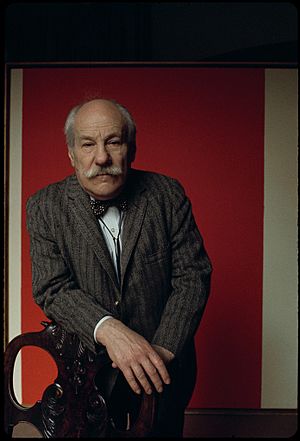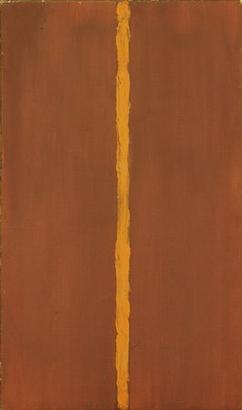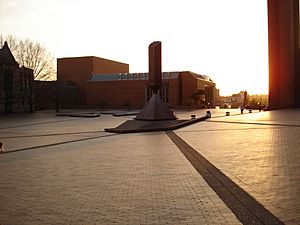Barnett Newman facts for kids
Quick facts for kids
Barnett Newman
|
|
|---|---|

Newman around 1969
|
|
| Born | January 29, 1905 New York City
|
| Died | July 4, 1970 (aged 65) New York City
|
| Known for | Painting, sculpture |
|
Notable work
|
Vir Heroicus Sublimis, The Stations of the Cross |
| Movement | Abstract expressionism, color field painting |
Barnett Newman (born January 29, 1905 – died July 4, 1970) was an American artist. He is known as a key figure in abstract expressionism. He was also a leading color field painter. His art explores how people feel when they experience a place through art. He used simple shapes to make these feelings stronger.
Contents
Early Life and Education
Barnett Newman was born in New York City. His parents were Jewish immigrants from Poland. He studied philosophy at the City College of New York. He also worked in his father's clothing business. Later, he worked as a teacher, writer, and art critic. In the 1930s, he started painting in an expressionist style. However, he later destroyed all these early works. In 1936, he married Annalee Greenhouse. They met while working as substitute teachers.
Developing His Art Style

Newman wrote articles and organized art shows. In 1948, he had his first solo art show. It was at the Betty Parsons Gallery. After this show, Newman said, "We are in the process of making the world... in our own image." He used his writing skills to promote his art. He wanted to show his unique artistic vision.
In the 1940s, Newman explored surrealist ideas. Then, he created his own special style. This style used large areas of color. These colors were separated by thin vertical lines. He called these lines "zips." At first, the color areas had different shades. Later, the colors became pure and flat. Newman felt he found his true style with his Onement series from 1948.
The "zips" in his paintings do two things. They create the painting's space. They also divide and connect the different parts. Art historian April Kingsley said the zips were like "flashing light of a nuclear explosion." She also compared them to the "Old Testament pillar of fire." This shows how Newman mixed powerful ideas with destruction and hope. The "zip" was a key part of his art for his whole life. Some paintings, like The Wild, are almost entirely made of a single zip. Newman also made a few sculptures that looked like three-dimensional zips.
Meaning in His Works
Even though Newman's paintings look abstract, they often have deep meanings. Many of his works were first untitled. But the names he later gave them hinted at specific ideas. These ideas often came from Jewish themes. For example, two paintings from the early 1950s are called Adam and Eve. Other works include Uriel (1954) and Abraham (1949). Abraham was a very dark painting. It was named after a biblical figure and Newman's father, who died in 1947.

His series of black and white paintings, The Stations of the Cross (1958–1966), is very famous. He started this series after a heart attack. The series is subtitled Lema sabachthani. This means "Why have you forsaken me?" These were the last words of Jesus on the cross. Newman felt these words had a universal meaning for his time. Many people see this series as a tribute to the victims of the the Holocaust.
Newman's later works used bright, pure colors. These were often on very large canvases. Anna's Light (1968) is his largest work. It is 28 feet wide and 9 feet tall. He named it for his mother, who died in 1965. Later in life, Newman also worked on shaped canvases. For example, Chartres (1969) is triangular. He also returned to sculpture. He made sleek steel pieces. These later paintings used acrylic paint instead of oil paint. His sculpture Broken Obelisk (1963) is very well-known. It shows an upside-down obelisk balancing on a pyramid.

Newman also created a series of lithographs. These were called the 18 Cantos (1963–64). Newman said they were meant to remind people of music. He also made a few etchings.
In 1948, Newman helped start the Subjects of the Artist School. Other artists like William Baziotes and Mark Rothko were involved. The school offered public lectures. Famous speakers like John Cage gave talks. However, the school closed in 1949 due to money problems. Newman is usually called an abstract expressionist. This is because he worked in New York City in the 1950s. He was friends with other artists in that group. His abstract style was new and different from European art. But he didn't use the messy brushstrokes of other abstract expressionists. Instead, he used clear, flat areas of color. This made his work a step towards post painterly abstraction and minimalist art.
For much of his life, Newman's art was not fully appreciated. Other artists like Jackson Pollock were more famous. But the important art critic Clement Greenberg praised his work. It was only later in his life that people started to take his art seriously. Still, he greatly influenced many younger artists. These included Donald Judd and Frank Stella.
Legacy
Newman passed away in 1970 from a heart attack in New York City.
Nine years after his death, his wife Annalee started the Barnett Newman Foundation. This foundation manages his art and works. It helps people study and understand Barnett Newman's life and art. In 2004, the foundation helped create a complete list of all Newman's artworks. In 2018, the Foundation gave over 70 artworks to the Jewish Museum in New York.
Selected Collections
Many public art museums around the world own works by Barnett Newman. Some of these include:
- Addison Gallery of American Art (Andover, Massachusetts)
- Art Institute of Chicago
- Cleveland Museum of Art
- Detroit Institute of Arts
- Hirshhorn Museum and Sculpture Garden (Washington D.C.)
- Kawamura Memorial Museum of Art (Japan)
- Kunstmuseum Basel (Switzerland)
- Los Angeles County Museum of Art
- Metropolitan Museum of Art
- Museum of Modern Art (New York City)
- National Gallery of Art (Washington D.C.)
- National Gallery of Canada (Ottawa)
- San Francisco Museum of Modern Art
- Smithsonian American Art Museum (Washington D.C.)
- Stedelijk Museum (Amsterdam)
- Tate Gallery (London)
- Whitney Museum of American Art (New York City)
Art Sales
After Newman became a recognized artist in 1948, he decided to focus only on his art. He and his wife lived mostly on her teaching salary. This continued until the late 1950s, when his paintings started to sell regularly.
In 1985, his painting Ulysses (1952) sold for $1,595,000. In 2013, his painting Onement VI (1953) sold for a record $43.8 million at Sotheby's in New York. This record was broken in May 2014. His work Black Fire I sold for $84.2 million at Christie's.
Images for kids
-
Broken Obelisk, Rothko Chapel, Houston, Texas
See also
 In Spanish: Barnett Newman para niños
In Spanish: Barnett Newman para niños
- Black Fire I
- Voice of Fire
- Broken Obelisk
- Vir Heroicus Sublimis


